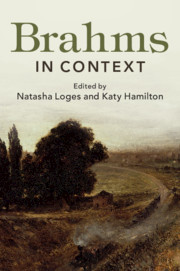Book contents
- Brahms in Context
- Brahms in Context
- Copyright page
- Dedication
- Contents
- Illustrations
- Music Examples
- Notes on Contributors
- Preface
- Abbreviations
- Part I Personality, People and Places
- Part II Identities, Environments and Influences
- Chapter 8 Finances
- Chapter 9 As Pianist
- Chapter 10 As Conductor
- Chapter 11 As Arranger
- Chapter 12 As Editor
- Chapter 13 As Teacher
- Chapter 14 Private Music-Making
- Chapter 15 Concert Life
- Chapter 16 Genre
- Chapter 17 Folk Music
- Chapter 18 Early Music
- Part III Performance and Publishing
- Part IV Society and Culture
- Part V Reception and Legacy
- Further Reading
- Index
- References
Chapter 10 - As Conductor
from Part II - Identities, Environments and Influences
Published online by Cambridge University Press: 15 May 2019
- Brahms in Context
- Brahms in Context
- Copyright page
- Dedication
- Contents
- Illustrations
- Music Examples
- Notes on Contributors
- Preface
- Abbreviations
- Part I Personality, People and Places
- Part II Identities, Environments and Influences
- Chapter 8 Finances
- Chapter 9 As Pianist
- Chapter 10 As Conductor
- Chapter 11 As Arranger
- Chapter 12 As Editor
- Chapter 13 As Teacher
- Chapter 14 Private Music-Making
- Chapter 15 Concert Life
- Chapter 16 Genre
- Chapter 17 Folk Music
- Chapter 18 Early Music
- Part III Performance and Publishing
- Part IV Society and Culture
- Part V Reception and Legacy
- Further Reading
- Index
- References
Summary
The earliest evidence of Brahms’s activity as a conductor comes from 1847, when as a fourteen-year-old he led a chorus of school children in the small town of Winsen near his native Hamburg. His last reported appearance on a podium was with the Berlin Philharmonic in January 1896, aged sixty-two. Over a span of almost fifty years between these two moments, Brahms conducted a wide range of amateur and professional ensembles in many different locations across the Austrian Empire, Germany and Switzerland.
Brahms’s activities on the podium coincide with the steady rise of the professional conductor during the nineteenth century, embodied in the Austro-German sphere at first by Weber, Mendelssohn, Wagner, Spohr and Spontini, and later by Richard Strauss, Mahler, Richter and Bülow.
- Type
- Chapter
- Information
- Brahms in Context , pp. 88 - 97Publisher: Cambridge University PressPrint publication year: 2019



